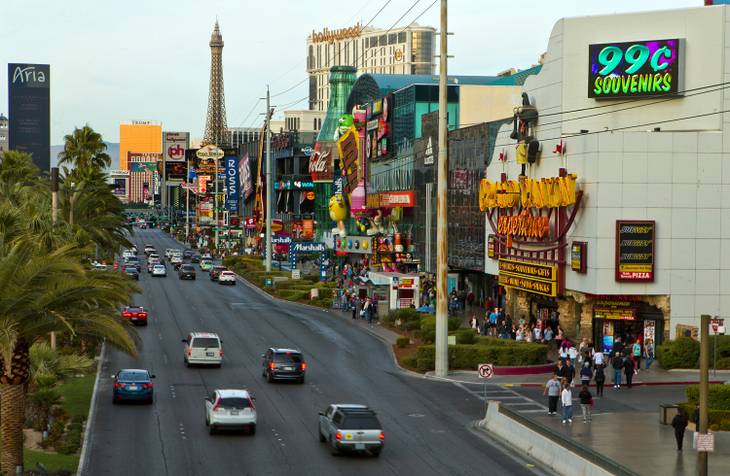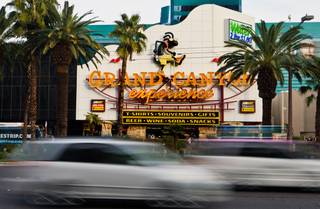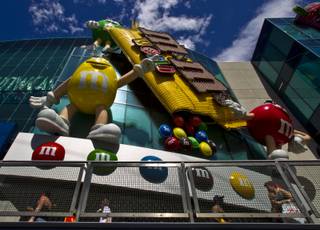It took them more than a year, but a group of New Yorkers have completed their nearly $370 million buyout of Showcase Mall on the Strip.
Jordache jeans founders, the Nakash family, and real estate investor Eli Gindi recently paid $82.85 million for a roughly 42,000-square-foot section of Showcase, which is known for its giant Coke bottle and M&M’s out front.
The sale, by Showcase’s original developer Barry Fieldman, closed Dec. 2, property records show.
Fieldman first invested in the site in the early 1990s. Back then, he said, Showcase’s current footprint had Chevron and Union Oil gas stations, as well as Island Plaza, a pink, single-story retail center.
The sale marks his exit from a property with a complex history of multiple owners, expansions, ground leases, and spats with higher-ups at neighboring MGM Grand.
“This has been a 25-year journey for me and my partners,” he said.
The purchase also gives the Nakash and Gindi group full control of a roughly 330,000-square-foot mall with little vacant space and heavy foot traffic out front — not to mention street performers — in the pedestrian-packed casino corridor.
And it’s the latest investment in a Strip retail property — a handful of new ones opened the past two years — as more tourists avoid card tables and slot machines to shop, dine, party in nightclubs and do other activities here.
Fieldman sold the mall’s southern portion, whose tenants include the Adidas sports-apparel store and the Grand Canyon Experience souvenir shop. Grand Canyon sells the usual mix of Las Vegas-themed paraphernalia, including ash trays, picture frames, clothing, flasks (“Party in the city that never sleeps,” says a 64-ounce, or half-gallon, flask), and shot glasses.
“I came to Vegas for the (expletive) and the drinks,” one shot-glass, with silhouettes of women in high heels, says.
Showcase, on Las Vegas Boulevard just north of Tropicana Avenue, is almost fully occupied and sits in a “prime location” on the Strip, Nakash Holdings managing director Jonathan Bennett said.
Foot traffic is “only getting better,” he said, noting that the 20,000-seat Las Vegas Arena is being built across the street. It’s scheduled to open in spring 2016.
He also said Showcase would get improvements to its facade and have an “ever-increasing variety of stores.”
Gindi, of Gindi Capital, did not respond to a request for comment Tuesday.
The Nakash family’s Jordache Enterprises conglomerate has investments in agriculture, clothing, real estate, aviation and television. Last year, after the Nakashes and Gindi bought their first portion of Showcase, Bennett indicated the group might spruce up the Coca-Cola bottle with LED lighting, Times Square-style.
They bought that 190,000-square-foot chunk in May 2014 for $145 million from New York investment firm Angelo, Gordon & Co. and San Francisco-based developer City Center Realty Partners. In January of this year, they teamed with New York home-curtains manufacturer Elyahu Cohen to buy a roughly 100,000-square-foot section for $139.5 million from Beverly Hills, Calif.-based Unilev Capital Corp.
Fieldman and developer Bob Unger opened the first phase of Showcase in 1996, said Fieldman, who butted heads with the MGM Grand.
“In board meetings, they called me ‘the cancer that grew,’” he said of casino management.
Only one or two people from those days still work for MGM, he said, and relations have been fine in recent years.
Fieldman, who moved to the valley in 1978, also said that in the late 1980s and early '90s, Las Vegas “was a pariah” largely shunned by corporate America. He noted that even when Citicorp opened a credit-card processing center here in 1985 — which business boosters saw as a major victory for a casino-heavy economy shaking off decades of mafia power — the New York financial giant scrapped “Las Vegas, NV” for its mailing address and opted for “The Lakes, NV.”
But in the '90s, Fieldman said, his group signed deals with Coca-Cola and M&M’s — brands that are as “apple pie” as any — to open stores on the Strip with prominent signage.
“Nobody else was heading that direction,” he said.
Today, the sidewalk in front of Showcase, like other parts of the Strip, is a magnet of sorts for another type of enterprise: busking.
On a visit this week, people dressed as Batman, Captain America, the Incredible Hulk, Iron Man, Mr. T and Tupac Shakur had gathered near an entrance to MGM Grand not far from Showcase, to take photos with tourists in exchange for tips. Others had lined up in formation, preparing to dance to thumping music.
Outside Grand Canyon Experience, 63-year-old Boris Ruiz, a Guatemala native who lives near UNLV, was wearing a Santa Claus outfit with the head of Mickey Mouse. He said he goes there three times a week sometimes and has made more than $200 a day.
Tourists stream past Showcase, he said, but not everyone who takes a picture with him coughs up some money.
“What can I do,” he said, plainly.


